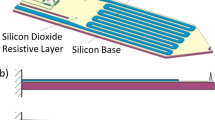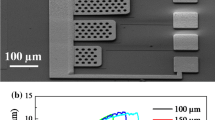Abstract
This paper models the residual stress distributions within micro-fabricated bimorph cantilevers of varying thickness. A contact model is introduced to calculate the influence of contact on the residual stress following a heat treatment process. An analytical modeling approach is adopted to characterize bimorph cantilevers composed of thin Au films deposited on thick poly-silicon or silicon-dioxide beams. A thermal elastic–plastic finite element model (FEM) is utilized to calculate the residual stress distribution across the cantilever cross-section and to determine the beam tip deflection following heat treatment. The influences of the beam material and thickness on the residual stress distribution and tip deflections are thoroughly investigated. The numerical results indicate that a larger beam thickness leads to a greater residual stress difference at the interface between the beam and the film. The residual stress established in the poly-silicon cantilever is greater than that induced in the silicon-dioxide cantilever. The results confirm the ability of the developed thermal elastic–plastic finite element contact model to predict the residual stress distributions within micro-fabricated cantilever structures with high accuracy. As such, the proposed model makes a valuable contribution to the development of micro-cantilevers for sensor and actuator applications.











Similar content being viewed by others
Abbreviations
- MEMS:
-
micro-electro-mechanical-systems
- t 1 :
-
film thickness
- t 2 :
-
beam thickness
- δ1 :
-
displacement of film
- δ2 :
-
displacement of beam
- ΔT :
-
temperature rise
- α1 :
-
thermal expansion coefficient of film
- α2 :
-
thermal expansion coefficient of beam
- θ:
-
slope
- ν:
-
deflection
- σ x :
-
residual stress distribution
References
Behrens I, Doering L, Peiner E (2003) Piezoresistive cantilever as portable micro force calibration standard. J Micromech Microeng 13:S171–S177
Brissaud M, Sarah L, Gonnard P (2003) Modeling of a cantilever non-symmetric piezoelectric bimorph. J Micromech Microeng 13:832–844
Chen CT, Nguyen H, Wu MC (1999) A low voltage micromachined optical switch by stress-induced bending. Proc IEEE MEMS 1999:424–428
Cho WI, Park NC, Yang H, Park YP (2002) Swing-arm-type PZT dual actuator with fast seeking for optical disk drive. Microsyst Technol 8:139–148
Cui T, Markus D, Zurn S, Polla DL (2004) Piezoelectric thin films formed by MOD on cantilever beams for micro sensors and actuators. Microsyst Technol 10:137–141
Ericson F, Greek S, Söderkvist J, Scheweitz JÅ (1997) High-sensitivity surface micromachined structures for internal stress and stress gradient evaluation. J Micromech Microeng 7:30–36
Fang W (1999) Determination of the elastic modulus of thin film materials using self-deformed micromachined cantilevers. J Micromech Microeng 9:230–235
Flinn PA, Gardner DS, Nix WD (1987) Measurement and interpretation of stress in a aluminum-based metallization as a function of thermal history. IEEE Transact Electron Device ED-34:689–698
Frühauf J, Gärtner E, Jänsch E (1999) Silicon as a plastic material. J Micromech Microeng 9:305–312
Helmbrecht MA, Srinivasan U, Rembe C, Howe RT, Muller RS (2001) Micromirrors for adaptive-optics arrays. Proc Transducers 2001:1290–1294
Hodge TC, Bidstrup-Allen SA, Kohl PA (1997) Stresses in thin film metallization. IEEE Transact Compon Pack Manuf Technol A-20(2):241–248
Kobayashi T, Murakoshi Y, Maeda R (2004) Development of a novel self-sensitive atomic force microscope for nondestructive measurement of micro vertical surfaces. Microsyst Technol 10:423–425
Kuang Y, Huang QA, Lee NKS (2002) Numerical simulation of a polysilicon thermal flexure actuator. Microsyst Technol 8:17–21
Lee CY, Lee GB (2003) Micromachine-based humidity sensors with integrated temperature sensors for signal drift compensation. J Micromech Microeng 13:620–627
Lee GB, Lee HH, Chou TT (2003) An investigation of the residual stress in thin films under thermal process. Proc Nano Microsyst Conf 2003:113–117
Lubecke VM, Barber B, Chan E, Lopez D, Goss ME, Gammel P (2001) Self-assembling MEMS variable and fixed RF inductors. J IEEE Transact Microwave Theory Tech 49(11):2093–2098
Pamula VK, Jog A, Fair RB (2001) Mechanical property measurement of thin-film gold using thermally actuated bimetallic cantilever beams. Proc Int Conf Model Simul Microsyst 2001:410–413
Peng W, Bhushan B (2003) Transient analysis of sliding contact of layered elastic/plastic solids with rough surfaces. Microsyst Technol 9:340–345
Petronis S, Gold J, Kasemo B (2003) Microfabricated force-sensitive elastic substrates for investigation of mechanical cell-substrate interactions. J Micromech Microeng 13:900–913
Su Y, Evans AGR, Brunnschweiler AB, Ensell G (2002) Characterization of a highly sensitive ultra-thin piezoresistive silicon cantilever probe and its application in gas flow velocity sensing. J Micromech Microeng 12:780–785
Wu CT, Hsu W (2002) An electro-thermally driven microactuator with two dimensional motion. Microsyst Technol 8:47–50
Acknowledgements
The authors would like to thank the financial support provided by the National Science Council in Taiwan (NSC 93-2218-E-212-011).
Author information
Authors and Affiliations
Corresponding author
Rights and permissions
About this article
Cite this article
Lee, CY., Tsai, CH., Chen, LW. et al. Elastic–plastic modeling of heat-treated bimorph micro-cantilevers. Microsyst Technol 12, 979–986 (2006). https://doi.org/10.1007/s00542-006-0115-1
Received:
Accepted:
Published:
Issue Date:
DOI: https://doi.org/10.1007/s00542-006-0115-1




